Menus
- Operation Seduction II
- Extend the performance envelope
- JLB technology (Jointless Belt)
- Multi-Tread coumpound technologiy
- Ride confidently in wet conditions
- Comfort objective
- Corsican tour
- Track to the stars
- Vicious circle
- Appraisal: Worthy heir
- Dimensions table:
- Interview
- ITW: Patrice Omont, Motorcycle Activity Director and Motorcycle Competition Europe.
Operation Seduction II
The journalists troop follow in the footsteps of opener Dunlop and leave Ajaccio on a 4-lane section with fast corners. Not reassured on my Benelli "Century Racer", I see the ribbon of asphalt moving at high speed and this great curve that never ends does not mean anything to me.. I am waiting for the first oscillations of the bike which will reflect my hesitation as to the path to follow…. But nothing comes. The curves pass as one threads pearls and nothing moves. Firmly on the corner, the Benelli remains unfazed, without the slightest hesitation. The Dunlop Roadsmart II has just started its seduction operation ….
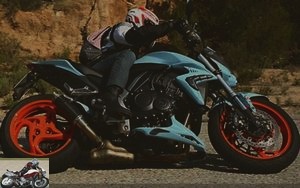
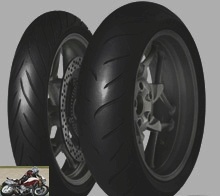 Appeared in 2007, the Dunlop Roadsmart was however not really obsolete since on the whole of its performances, our colleagues of das Motorrad and Moto Magazine gave it the victory during a comparative test carried out in 2011. However, in a constantly evolving motorcycle universe, Dunlop has deemed a redesign necessary to adapt its Sport GT tire to the new requirements of today’s motorcycles and bikers.
Appeared in 2007, the Dunlop Roadsmart was however not really obsolete since on the whole of its performances, our colleagues of das Motorrad and Moto Magazine gave it the victory during a comparative test carried out in 2011. However, in a constantly evolving motorcycle universe, Dunlop has deemed a redesign necessary to adapt its Sport GT tire to the new requirements of today’s motorcycles and bikers.
In fact, in recent years, there has been a clear trend towards an expansion of the radial sport touring market (around + 50% in ten years), even if the hypersport segment remains the largest in France to this day. Confronted with the crisis, but also with road repression, motorcyclists are abandoning sports cars in favor of roadsters which they equip with tires having a greater longevity. However, this new breed of customers still expects a high level of performance from their tires. This is what forces manufacturers to succeed in the big gap, by offering tires that must display a versatility capable of attracting a very diverse clientele. Sports cars used on the road, roadsters, big trails, big GTs, hypermotards, the gt sport tire of the new decade must be able to satisfy a very wide range of users.
Extend the performance envelope
Starting from the excellent foundation of the Roadsmart, the engineers at Dunlop have therefore focused their attention on the relative weaknesses of their product to improve it and bring it up to the level of the best competitor in almost all areas. Simple on paper, the specifications have everything to square the circle: a single tire for a wide variety of types of motorcycles, high performance in wet and dry braking, more handling, increased comfort and longevity, all in a tire that gives the pilot confidence…. phew, that’s a lot! And if not, technically what do we do to achieve it? ?
JLB technology (Jointless Belt)
Literally seamless belt, this process was already present on the Roadsmart. The construction uses a different density of threads between the front and the back. Indeed in front, it allows to reduce the resistance in turns (more maneuverability therefore) and reduces the shimmy (tendency to handlebar at low speed, noticeable when you let go of the handlebars at around 50 km / h).

At the rear, on the other hand, Dunlop has increased the lateral stiffness of the Roadsmart II by 15% in an effort to improve stability at high speeds and reduce the tendency to sway. Quite logically, the Roadsmart II also incorporates the "Multi-Tread coumpound technologiy", which means more prosaically that it is a dual-compound rear tire..
Multi-Tread coumpound technologiy
A harder rubber covers the central tread of the tire (i.e. between 20 and 25% of the total surface) to provide more longevity. Concretely and with a certain caution, the engineers present announced an improvement in the mileage traveled slightly exceeding 20% compared to the Roadsmart. They also humbly admit that they are still a few% (around 8) behind the leader in this field, which would be the Michelin Pilot Road 3 by Dunlop’s own admission. It was therefore he who served as a reference throughout the evolution of the Roadsmart II, a nice compliment by the way..
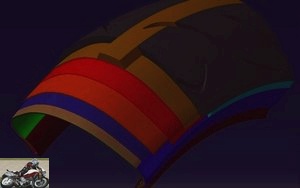
However, with each company having its own philosophy, each other’s priorities are sometimes different. Thus, Dunlop, which always attaches great importance to grip on dry ground, claims here a clear superiority over its competitor. It is the use of a new type of "highly dispersible" silica and liquid polymers which improves adhesion in cold weather for the first, the rise in temperature and resistance over a wider temperature range for the second..
Ride confidently in wet conditions
The preserve of the Michelin PR3, wet efficiency has been the subject of extensive work by Dunlop to keep up with its competitor. In addition to the compound mixes, Dunlop worked on the profile of their tire and the gouging rate. Up front, a constant footprint regardless of the bank angle promotes feedback to the pilot. At the rear, the footprint increases with lean to improve grip and help gain grip when accelerating to angle. But it is above all the notching rate that will improve handling in wet conditions. As we said, it is constant at the front wheel (around 15%) to provide stable performance and give the rider confidence. At the rear, it increases because the more you lean, the less the drainage effect of the front wheel is felt since the tires are no longer on exactly the same trajectory..
In fact it starts from 7% at 0 °, to rise to 14.5% at 40 °. In addition, the design of the grooves does not close when they come into contact with the ground, which ensures optimal water evacuation regardless of the angle of inclination. On paper, Dunlop claims to have managed to rise to the level of its competitor and intends to prove it to us in practice… .. We will see.
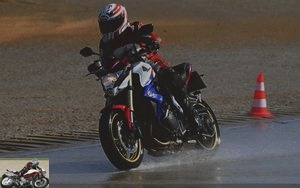
Comfort objective
Obviously important in this segment, driving comfort has been taken into account. This is all the more important since the Roadsmart II does not claim a reinforced carcass variant to equip a heavy GT which when loaded can curl the ½ thunder with its passengers. Capable of equipping a Ducati Hypermotard to the other extreme, this GT sport must offer great damping capacity. It is therefore in this area that Dunlop has worked to significantly improve shock absorption capacity. Automotive tests were applied here to characterize the level of comfort obtained. A reduced reaction force and rapid damping of impacts have been sought. Construction and profile of the tire are decisive elements here which have made it possible to obtain a marked improvement over the Roadsmart according to the manufacturer.
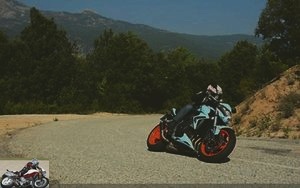
Corsican tour
Our test begins with a road trip of around 300 kilometers on Corsican roads. The very varied course takes place in good weather on dry, but often degraded asphalt, with its share of surprises: cows that believe themselves to be sacred and occupy the road at the end of the curve, often leaving a few dung, herds of wild pigs in goguette, road in more or less signaled works, dust, bumps and other gravel, all swallowed at a good pace behind an opener on the right wrist that is both supple and generous. In this difficult context, the Roadsmart II enchants. Never faulted by the grip, the pilot approaches the difficulties with serenity, whatever the machine used: frenzied Hypermotard, BMW 1200 RT, incredible ease on these small roads, Triumph Street Triple that the testers are snapping up, Honda CB 1000 R for the big game, or the amazing Honda Crossruner that I use for the first time on the road.
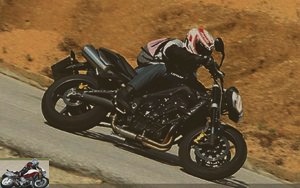
All these bikes with such different weights and characteristics react wonderfully to the presence of the new Dunlop. The handling is perfect and it is only on the Multistrada that one encounters stability problems at high speed… .. As with all the other pneumatic mounts on this extremely manoeuvrable model. A very convincing first round therefore.
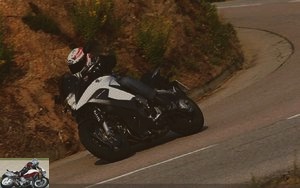
Track to the stars
The next day, we’ll be able to do a few laps on the Mireval track on the 2011 GSXR 750. Less torquey and devastating than the 1000 for their tires, the 750 will delight us with their maneuverability and their balance on this hilly track. Machines fitted with BT 23 and Michelin PR 3 will allow us to assess the differences in behavior between climbs, but let’s face it, there are nuances here for an average rider who will not go to the limits of the tire. The grip is excellent and everyone was up to the task during this test..
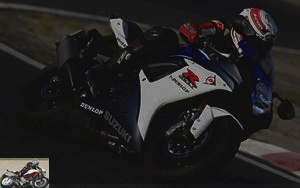
Vicious circle
To demonstrate the excellent angle stability of the Roadsmart II, Dunlop invited us to ride on a circular track 200 m in diameter, letting our hands go at 60, 90 and even 110 km / h. This test assesses the attitude of the tire on the angle and its ability to stay on course. During this test, competition is also present. We have to admit that the Dunlop, more stable and more consistent than the others, confirms here the impression we felt during the first fast corners. At 90 km / h on the corner, you ride with both hands released, looking at the landscape in the distance, even fixing your gaze on the sea without the motorcycle leaving its circular path. Reassuring we tell you !
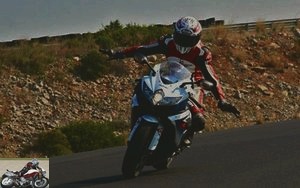
Let’s fall in the rain ….
Last exercise, the inevitable course on a copiously watered track. Unfortunately, it will begin for me with a small fall for having recklessly left the trajectory trying to avoid the spray of water raised by a colleague in front of me. The bike used at the time was shod in Bridgestone BT 023 and the front end was not really reassuring (that’s the one I lost). Moreover in this session the other motorcycle equipped with BT 023 also went to the mat. But before definitely burying this tire on wet ground and without questioning the word of our hosts, let us mention that we do not have all the parameters of this test organized by Dunlop on its own track…. Cooled by this gap, I would be more careful thereafter. However, I have found that the Roadsmart has nothing to be ashamed of against the Michelin PR3. The front Dunlop even displays better angle stability (more constant profile) while going through water gulls is much less destabilizing. On the other hand, it is undoubtedly a little less gripping in terms of traction than the PR3, undoubtedly due to its low notching rate when the bike is vertical (only 7%). It therefore appears that Dunlop’s technical teams have indeed managed to rise to the benchmark level in the segment. An impression confirmed by the lap times on a lap with the different climbs present and also by the data acquisition:
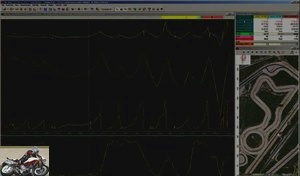
The yellow curves relate to the motorcycle wearing Dunlop Roadsmart II, the blue ones to the Michelin Pilot Road 3, and the pink ones to the Bridgestone BT 23.
On the photo from the bottom right we can see the drawing of the track and the position of the motorcycles marked with dots (towards the exit of the circle bend). The values displayed in the table correspond to the instantaneous data at this location, marked by a vertical line crossing all the curves. From top to bottom, the curves describe the engine speed (RPM scale in green on the right side), below the speed in km / h (V GPS: red scale on the left). Still below, the throttle opening in% (TPS 0% closed gas, 100% = full throttle, pink scale on the right). Finally at the bottom we see the angle of inclination of the motorcycle expressed in degrees (Banking GPS: red scale on the left, positive value if the motorcycle leans to the left and negative if it leans to the right, zero when it is vertical). The lap times achieved by tester Dunlop are shown in the bottom row. (1.12, 1.14 and 1.16). If for the Bridgestone, the hierarchy is indisputable, during our tests, the Michelin / Dunlop difference was tighter.
Besides the fact that the Bridgestone is set back, we notice that the lean angle of the bike is more stable with the Roadsmart II while it oscillates around a median value with the Pilot Road 3, which is less reassuring for the pilot and that we actually felt.
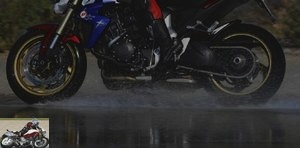
Appraisal: Worthy heir
Very successful, the Roadsmart II arrives on the market with very solid arguments. It has been available since October 1 at a "premium" price, which is to say close to the best tires in the segment. Concretely, Dunlop announces a forthcoming increase of its tariffs of 7%. This is the price difference that we should see between the current price of the Roadsmart which will disappear and that of the Roadsmart II which now replaces it..
Also note, a second round of dimensions which will arrive in April 2012 to equip, among other things, big trails.
Strong points
- Consistent and reassuring behavior
- angle stability
- The grip in the dry as in the wet
- Improved endurance (to be confirmed)
Weak points
- The rising price
- The many dimensions and particularly the "trails" (19 inches) which will only be available in the spring.
Dimensions table:
AV 120 / 60ZR 17, 120 / 70ZR 17 to come: 110 / 70ZR 17, 110 / 80ZR18, 120 / 70ZR18, 110 / 80R 19
AR: 150 / 70ZR17, 160 / 60ZR17, 180 / 55ZR17, 190 / 50ZR17. Coming soon: 170 / 60ZR17, 160 / 60ZR18, 190 / 55ZR17
Indicative price: less than 300 € the train of 120/70 and 180/55 ZR 17.
Interview
Photo Patrice Omont
ITW: Patrice Omont, Motorcycle Activity Director and Motorcycle Competition Europe.
 Le Repaire: When we have a tire that a few months ago still wins the comparative tests of our colleagues "Das Motorrad" and "Moto Magazine", why do we change it? ?
Le Repaire: When we have a tire that a few months ago still wins the comparative tests of our colleagues "Das Motorrad" and "Moto Magazine", why do we change it? ?
PO. : The Roadsmart appeared 4 years ago in 2007 in a very competitive market where new products are constantly arriving. So it’s important to evolve to stay at the top level and even though we are still there, we didn’t want to wait until we lost our head start to change. In addition, there is also the allure of novelty which re-energizes sales..
LR: How did you choose the criteria for development ?
PO: We have taken into account the needs of motorcyclists in this segment which, given the level of performance of our tire, concerned comfort and longevity. Comfort was not a strong criticism, but in the GT sport segment it is a parameter to be taken into account. Longevity is also highly sought after and it is this area on which we have made a lot of progress. In addition, we already had an excellent level of grip on dry roads, but we also wanted to improve on wet roads, given the progress of the competition (Patrice Omont makes particular reference to the Michelin PR3)..
LR: By improving certain aspects, don’t you risk degrading others, for example by providing more comfort, don’t we lose rigidity and stability? The increase in mileage, is it not accompanied by a loss of grip ?
PO: The tire is by definition a “composite”. Touching a parameter modifies the other criteria. There are indeed contradictions, but getting around them is the subtlety of our job. Our goal is to broaden the tire’s performance envelope without degrading any of its basic qualities. For this we rely on technological progress and especially on excellent simulation tools.
LR: Can it be said that the Roadsmart II is an entirely new tire? ?
PO: The differences with the Roadsmart are certainly significant, but this is an evolution, not a revolution. The basic technology remains the same. The profile of the tire, and therefore the molds, have been modified to improve control over the angle, the rubber mixture has changed, the designs have changed ….
LR: You insist on the high tapping rate up to 40 ° incline for better water drainage. But in the rain, which leans at 40 ° ?
PO: On the Mireval track, where the level of grip is average, our testers reach 30/33 ° incline. However, there are more grippy bitumens elsewhere, but to really feel the differences between the tires, you don’t need too much grip. For us it was important to have very good water drainage on the corner to reassure the pilot.
Related articles
-
Metzeler Roadtec Z8 M / O tire test
The first Metzeler bigomme Born 2 years ago, the Roadtec Z8 is being upgraded under the impetus…. competition ! To explain the details to us and make us…
-
Bibendum takes care of its line for its dual-compound sport tire Michelin has just presented its brand new tire, the Michelin Power Pure, on the Almeria…
-
3.5 seconds faster *! * Than the Pilot Power 3 tire according to Michelin There will be a before and an after announces David Jean, the sales manager,…
-
It’s on the private test circuit located in Mireval, near Montpellier, which Dunlop presented at the start of the week its new dual compound tire. Called…
-
Bridgestone S20 hypersport tire test
Sport according to Bridgestone. Just a year after the arrival of a BT 16 Pro which performs particularly well on wet roads, Bridgestone is driving the…
-
Michelin PR4 tire test: 4th dimension
With the Michelin PR4, the Pilot Road tire enters the 4th dimension Supplied as original equipment on 40% of new BMW R 1200 RTs and already available in…
-
Pirelli Diablo Rosso IV tire test
The devil in detail ! The Diablo Rosso IV is the latest Pirelli sport tire and yet intended for road use. The latest tire once again sets the bar very…
-
Bridgestone T32 and T32 GT tire test
The do-it-all Sport Touring tire 22 sizes and a GT version Since Bridgestone has renamed its tires with clear names, it is much easier to navigate than…
-
Metzeler Interact tire comparison test: Roadtec Z8, Sportec M5 and Racetec K3
Comparison test of the Roadtec Z8, Sportec M5 and Racetec K3 At a time when most manufacturers swear by multigums, Metzeler persists and signs with its…
-
Tire test: the Sportsmart2 goes into fourth gear
The spearhead of the Dunlop hypersport range, Sportsmart is handing over to Sportsmart2 after 3 years of a brilliant career. It was at the factory, but…
Admittedly this new Yam has many equipments but some can seem useless to us, even to be a hindrance to the purchase. It is the case for me of the piloted suspension which one sees generalizing among all the manufacturers with the key an additional cost of 1500 to 2000 euros and foreseeable breakdowns + prices of indecent repairs. So a Yam 1200 Tenere has more than 16,000 euros, they can keep it and it is not this very low price that will boost its sales..
Franck
It all depends on what you are looking for … Each brand tries to create a "philosophy" which corresponds to a marketing plan dedicated to types of buyers and a style which corresponds more to a dream than a need. As an example, I prefer the KTM "R" even though I have no objective need for its off-road performance. My idea is to tell myself that far, it’s not that far …
Salvation

Nothing to say about this essay. Everything has been said and well said
Maybe over long distance, the comfort disappears a bit.
Personally, my rear brake blocks easily (set here with ABS ….)
It is high and I like it … except for the maneuver, because the bougresse weighs 210 kgs with the full tank and beware of the slopes.
Suitable for TT. Besides, it’s a trail, a real one.
Does not consume anything (- 4 liters / 100), personally and I have already said it here, I arrived at 550 kms with still almost 2 l in the tank … So the 600 kms of autonomy are possible….
Only downside: its price € 8000 a "banal" mono 660 cm3 is expensive….
V
Hello,
I agree with your "downside" on the price.
How to admit that a roadster costs € 7,000 and a 660 Tenere € 8,000 ?
In the US there is the klr650 at 6000 €.
Why on earth is the Tenere at this price? ?
it’s dead in the egg looks like the other.
In addition we can not try it, because never available in concession.
Ciao
Thank you for the conclusion of the conclusion which sums up what drives many of us … and makes me want to buy a Trail!

One day all the bikers will have to stand up to protest against the too high prices of the machines. You will tell me, falling sales is the most appropriate response. Yes, but it can be interpreted differently: the crisis, the power of the model or the innovations that did not please. And what is the response of the manufacturers? offer smaller displacement, made in Asia with less reliable parts.
Tell me how can a BMW G310r be worth 2700 euros in India and over 5000 in Europe? If it is taxes, there is a serious problem to be dealt with. We are told about globalism, equality and the abolition of borders but I only see inequality and savage capitalism.
It’s the same as with the license, speed cameras and anti-motorcycle laws. In Asia there is very strong growth because we do not piss off people by putting obstacles in their way. It is as if we put obstacles in Europe to see it sink. So that the USA can dominate it more easily. The bikers will have to wake up.
Thank you for this great article which perfectly sums up this bike and the spirit it generates.
Personally, I have been riding with it for over two years and I am delighted with it. Its performances are in my eyes more than enough to have (very) pleasure. 145km / h of highway cruising is not a problem, it goes way beyond (although I am careful to stay below 140 on long runs). She is reliable and safe, not unpleasant in a duo and, above all, she exudes a wonderful scent of adventure at every start; whether to go buy bread 1km away or to embark on a long journey.
The end of the article sums up my impression very well:
"The Tenere actually has few limits. It’s a motorcycle that makes you want to ride a motorcycle, if only to nurture that need for escape and freedom that is inherent in motorcycling.".
Greetings to all, and have a good trip !